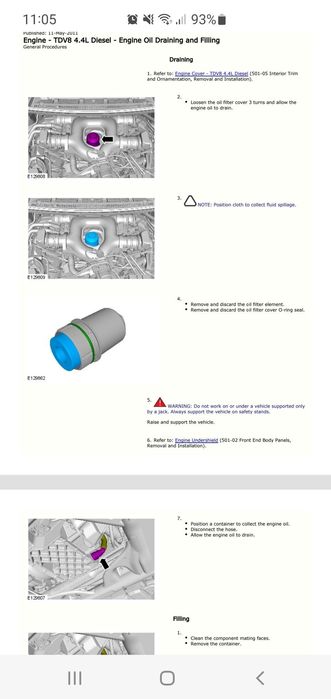 | Home > Technical (L322) > Why TDV8 turbos fail |
 
|
|
|
| Zerocult Member Since: 29 Aug 2021 Location: Jaén Posts: 7  
|
I am going to explain my opinion given my experience as an RR owner.
|
||
|
| JayGee Member Since: 27 Jul 2021 Location: London Posts: 2665  
|
What part of the 'actuator'? If it's the waste gate on the exhaust side of the turbine I'd not put any grease on there at all nor should it need it.
Only use the oil specified by LR. Not just cheap oils but also very expensive pure synthetic oils don't deal with sludge very well.
Never drive any car hard (turbo or otherwise) until the engine is up to operating temperature. It's not the coolant temp on the dash either but the oil temperature. Assuming the turbo's on the 3.6 are watercooled and you are using the correct oil they shouldn't need a cool down period - this is only applied to early turbo charged cars which ran old mineral oils and no watercooling. Spin down time is also false unless you redline it and then switch off the ignition. A small turbine doesn't have much inertia and will spin down very quickly.
It would seem the whole turbo/EGR/intake setup on the 3.6 is a poor design not just the 'actuators'. Not sure about the built in failure to ensure workshop revenue - if so why did JLR replace the 3.6 with the 4.4 at the end of it's production run? 2012 TDV8 Vogue (L322) |
||
|
| RRover Member Since: 17 May 2021 Location: Sussex Posts: 278 
|
So there is a second sump drain plug? I only came across this recently on a really good YouTube video ("I did a 200,000 mile service on the cheapest 4.4 TDV8 Range Rover L332") and noticed this on one of the comments below only - the owner of video did not do this. The comment said that the second drain plug was at the rear of the engine, about an inch and a half from the subframe?!? And that this second plug drains the turbos?!? Does that sound correct?!? Also: would you suggest injector cleaner added to fuel via tank fill or is priming the fuel filter while renewing OK?!? How do you prime the fuel filter? I just received Rimmer oils and filters - are these generally OK? |
||
|
| garyRR Member Since: 13 Mar 2021 Location: Hampshire Posts: 1341 
|
The second plug can be seen sitting just above the subframe. It's a flanged bolt and is drains the turbo.
|
||
|
| RRover Member Since: 17 May 2021 Location: Sussex Posts: 278 
|
Cheers for that - I've made careful note.
|
||
|
| mjdronfield Member Since: 04 Nov 2011 Location: Derbyshire Posts: 7632  
|
Plastic ring on top of the engine when you take the acoustic cover off.
|
||
|
| Kot Member Since: 10 Mar 2021 Location: broadland Posts: 1089 
|
So does this mean dealers and most of us using the vacuum pump method are not draining this second turbo sump? 2018 SE SDV8 4.4 Byron Blue |
||
|
| garyRR Member Since: 13 Mar 2021 Location: Hampshire Posts: 1341 
|
The turbo of course also cycles through oil so it doesn't necessarily sit there and go old. I think it's around another 100ml (ish) that can be removed, so compared to a 9L fill, the figure is insignificant. 2015 Range Rover Autobiography 4.4 SDV8 |
||
|
| RRover Member Since: 17 May 2021 Location: Sussex Posts: 278 
|
Wasn't the vacuum pump thing so that Dealers could cut their service time periods down by not having to remove the under tray thingies? Not that service prices reflected this... |
||
|
| RRover Member Since: 17 May 2021 Location: Sussex Posts: 278 
|
So is the additional drain plug simply there to enable a drain of the turbos on their own so that work on them is less - oily? |
||
|
| garyRR Member Since: 13 Mar 2021 Location: Hampshire Posts: 1341 
|
Most likely so for maintenance to the turbo.
|
||||
|
| JayGee Member Since: 27 Jul 2021 Location: London Posts: 2665  
|
No need with modern water cooled turbo’s and synthetic oil to do a rundown / cool down / idle before shutdown but be aware that oil temps lag a long way behind coolant temps on cold start - give it at least 20mins more. 2012 TDV8 Vogue (L322) |
||
|
| RRover Member Since: 17 May 2021 Location: Sussex Posts: 278 
|
All great tips.
|
||
|
| jaguar3 Member Since: 25 Sep 2022 Location: Estonia Posts: 193  
|
If check maintanence history on mine, I can see always new drain plug bolt. So on mine 4,4TDV8 oil was drained from turbo reservior always with every maintanence (of course never know was it really drained or just add to invoice).
|
||
|
 
|
|
| All times are GMT + 1 Hour |
< Previous Topic | Next Topic > |
Posting Rules
|
Site Copyright © 2006-2024 Futuranet Ltd & Martin Lewis
![]()



